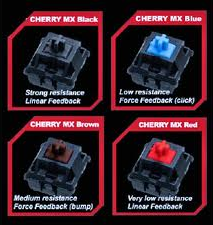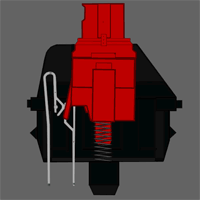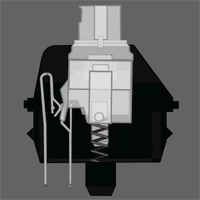Netspark’s hardware test: Corsair K90
 When it comes to gaming, one instantly thinks of Logitech, RAZER & Co.
When it comes to gaming, one instantly thinks of Logitech, RAZER & Co.
But it’s not only the Mice that belong to gaming, it’s also the Keyboard.
Corsair decided to bring us the Vengeance Gaming series, which contains
Headsets, Keyboards and other gaming-related stuff.
This test aims at the Gaming Keyboard Vengeance K90. So how could this keyboard cope with the top-notch Logitech G19 keyboard?
First of all, the K90 uses non-rubberdome Red Cherry MX switches which come with a 45g keystroke resist. Easy typing is the result.
 The Cherry MX Red switches are the switches with the least resistance requiring only 45g pressing weight to push them down entirely.
The Cherry MX Red switches are the switches with the least resistance requiring only 45g pressing weight to push them down entirely.
The Cherry MX Black is the stronger variant of the red and can require up to 80g press force to act
The Cherry MX Blue are at 50g resistance and 60g resistance for the tactile feedback and contact
The Cherry MX Brown go at 45g resistance and 55g contact resistance.
The Cherry MX Clear go at 55g resistance and 65g contact resistance.
So how to the switches relate to each other? And what is meant with linear and tactile feedback?
Have a look at the different switches to understand their functionality.
The MX Blue is the only classic key switch that “clicks” when pressed and thus is the only switch with audible feedback upon keystroke.





So the tested K90 has Cherry Red MX switches, which are rather rarely used for keyboards as they tend to false typing and too soft feeback. Although I am a rough typer, I like the soft key touch as it is more relaxing on the fingers and not giving much of a finger pain when typing long texts. The greatest advantage about the MX switches is their longevity! More than 10 million types per key and 50 million types per key group let you guess how long this keyboard may last until one of the keys give in. To be honest: No keyboard I’ve used ever had malfunctioning keys so far. They mostly failed working due to my rough treatment such as spilling liquids over them, causing circuit burning or the like.
So what you can expect, is a reliable keyboard that lets you feel comfortable during writing or gaming.
The only keys that seem to use rubber domes and no MX switches are the G-Keys (which hold predefined macros) and the more unusual keys, like Home, Del, PgUp, PgDn… but who cares? The most important keys are equipped with MX switches and thus allow you comfortable typing at 99.99% of the time.
And what about Ghosting and missing keystrokes?
The keybard perfoms well when doing the test with keystrokes. Hold down both SHIFT keys and type the following text:
THE QUICK BROWN FOX JUMPS OVER THE LAZY DOG
If your keyboard is manufactured well, all the text appears without missing letters. Some keyboards loose letters as their key logic and key matrix doesn’t allow typing certain keystroke matrixes to be typed at the same type.
I’ll type a review about this later on so you’ll be able to understand better what I am talking about.
And what’s the verdict about the Cosair K90?
Well, let’s say: It has a better typing character than the Logitech G19 but is missing the technical features such as a LCD that keeps you informed about different information statuses.
So while the K90 is now my primary typing tool, the G19 is my featured keyboard when it coes to information and effects.








 Users Today : 378
Users Today : 378 Users Yesterday : 348
Users Yesterday : 348 This Month : 12495
This Month : 12495 This Year : 169779
This Year : 169779 Total Users : 1034074
Total Users : 1034074 Views Today : 1289
Views Today : 1289 Total views : 4071118
Total views : 4071118
Leave a comment